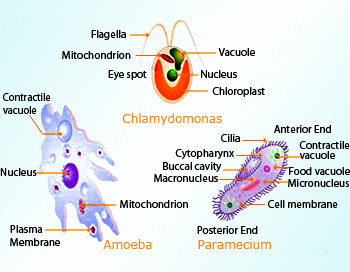 Different shapes of cellular organisms
Amoeba − Irregular shaped, Paramecium − Unicellular ciliate protozoan and slipper shaped, Chlamydomonas − Unicellular photosynthetic flagellate and oval shaped
Different shapes of cellular organisms
Amoeba − Irregular shaped, Paramecium − Unicellular ciliate protozoan and slipper shaped, Chlamydomonas − Unicellular photosynthetic flagellate and oval shaped
Cell is the fundamental structural and functional unit of all living beings. The cell is as fundamental to biology as the atom is to physical sciences. All living things are made up of one or more cells. Cells are the smallest structures capable of independent existence and of performing basic life processes, such as taking in nutrients, expelling waste, and reproducing. Hence cell specialization is also considered as cell differentiation.
All living beings, plants and animals, start their life with a single cell. Indeed, there are diverse forms of life existing as single−celled organisms or unicellular organisms to multicellular organisms; their bodies are composed of different kinds of specialized cells where they are organized as into higher levels of organization, such as tissue systems and organ systems. Cells are singled out as the organisms basic unit of life.
Many small plants and animals are made up of just one single cell. All the cells are related as they originate from the earlier cells. The cells have the capacity of responding to the environment fluctuations. In other words cells are considered as the smallest unit of living matter that enables to carry out the processes of life.
Eg: Yeast, Bacteria, Chlamydomonas, Amoeba and Paramecium.